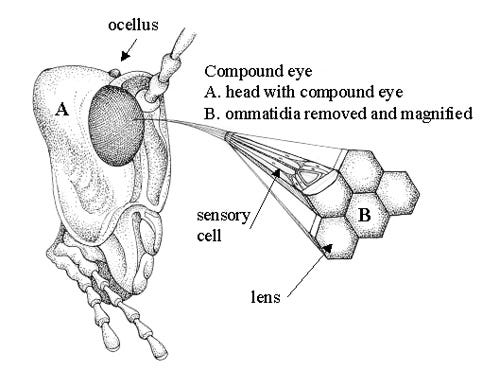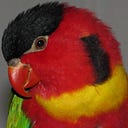30,000 Facets Give Dragonflies A Different Perspective: The Big Compound Eye In The Sky
A closer look at dragonflies’ amazing eyes
by GrrlScientist for ScienceBlogs.com | @GrrlScientist

Color vision in humans depends upon three light-sensitive proteins, called opsins, that are present in our retinas. Each type of opsin absorbs one color of light in the spectrum. In humans, the colors absorbed by these opsins are red, green or blue. The many wavelengths of light reflected into our eyes from the surfaces of objects around us mix together to provide a rich palette of color. Yet, despite our visual color range, there is a creature with even greater scope; the dragonfly.
Dragonflies are classified into the insect order Odonata (suborder: Anisoptera; different wings) which also includes the physically smaller and slower-flying damselflies (suborder: Zygoptera; twin wings). Dragonflies are characterized by their large multifaceted or “compound” eyes, two pairs of strong transparent wings, and an elongated body. Interestingly, even though they possess six legs (as do all insects), dragonflies cannot walk. Odonates are predatory as adults and the aquatic larvae (nymphs) can deliver an impressively painful bite — as I discovered when I was a child, catching them bare-handed in a local pond.

All dragonfly species have excellent vision. Each compound eye is comprised of several thousand elements known as facets or ommatidia. These ommatidia contain light sensitive opsin proteins, thereby functioning as the visual sensing element in the compound eye. But unlike humans, day-flying dragonfly species have four or five different opsins, allowing them to see colors that are beyond human visual capabilities, such as ultraviolet (UV) light. Together, these thousands of ommatidia produce a mosaic of “pictures” but how this visual mosaic is integrated in the insect brain is still not known.

“They are segregated in the compound eye so that the upwards facing eye has only blue and UV receptors, and the downwards facing eye has receptors for longer wavelengths, [such as] green and orange,” says Robert Olberg, dragonfly vision expert and professor of biology at Union College in Schenectady.
This patterned concentration of opsin types, particularly those sensitive to blue and UV light, gives special advantages to hunting dragonflies. For example, it is thought that the sky appears to be very bright to a dragonfly, thereby providing a clear background against which small moving prey can be easily detected, according to Dennis Paulson, dragonfly expert and director emeritus of the Slater Museum of Natural History at the University of Puget Sound, in Tacoma.
Are there color-blind dragonflies?
“We don’t know,” replies Paulson. “There are some [species] that tend to fly only at dusk; perhaps some of them have limited color vision.”
Dusk-active dragonflies have sacrificed most of their color vision in favor of increased light-collecting capacity by having fewer, larger facets in their eyes. They also lack all color sensitive opsins except green, which provides the broadest range of light sensitivity for any opsin. As a result, these dragonfly species probably also have a corresponding decrease in overall color perception.
Dragonflies (and bees) have the largest compound eyes of any insect; each containing up to 30,000 facets, and the eyes cover most of the insect’s head, resembling a motorcycle helmet. In contrast to a human eye, each facet within the compound eye points in a slightly different direction and perceives light emanating from only one particular direction in space, creating a mosaic of partially overlapping images. Does this mean that dragonflies have 30,000 eyes?
“No,” replies Olberg. “It’s more like a human having 10,000 to 30,000 photoreceptors spread out across the retina — but better than that because each facet has several spectral types of receptors.”
Dragonflies can also detect the plane of polarization of light, which humans cannot do without the aid of sunglasses. The advantages of this capability are unknown for dragonflies, but other insects are known to use polarized light as a sort of “sky compass” by which they navigate.
Another visual advantage of the multifaceted eye is a dragonfly’s acute sensitivity to movement, as anyone who has tried to catch one can tell you.
“Dragonflies can see in all directions at the same time. That’s one of many advantages of a compound eye; you can wrap it around your head,” explains Olberg. “The spherical field of vision means that dragonflies are still watching you after they have flown by. However, the backward-looking part of the eye has rather low resolution. So, if you want to catch a dragonfly, let it go by you and then swing your net like a baseball bat from behind. If you swing at them while they are approaching they’ll usually see the net coming and easily avoid it. They are awfully good at what they do.” Olberg concludes.
Many thanks to Professor Robert Olberg, who graduated with a PhD from the UW’s Zoology Department, Dennis Paulson, director emeritus of the Slater Museum, and Professor David O’Carroll, who studies insect vision at the University of Adelaide in Australia (after a brief time at the University of Washington, where I met him whilst I was a graduate student) for allowing me to interview them for this story.
Enjoy my writing? Please click on the green heart on the left side to recommend this piece. Follow me on Medium for more like this.
.. .. .. .. .. .. .. .. .. .. .. .. .. .. .. .. .. .. .. .. .. .. .. .. .. .. .. .. .. .. .. .. .. .. .. .. .. .. .. .. .. .. ..
GrrlScientist is very active on twitter @GrrlScientist and you can follow all her writing by subscribing to her TinyLetter
The original (shorter) print version of this piece was published in the University of Washington Biology Department newsletter. Rewritten, reformatted and first published online at scienceblogs.com on 8 July 2009.
